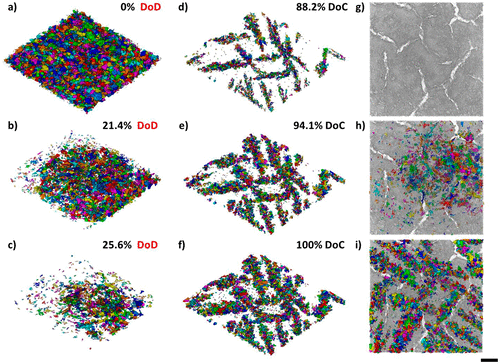Thermo Fisher Scientific › Electron Microscopy › Electron Microscopes › 3D Visualization, Analysis and EM Software › Use Case Gallery

Lithium sulfur (Li–S) batteries have great potential as a successor to Li-ion batteries, but their commercialization has been complicated by a multitude of issues stemming from their complex multiphase chemistry. In situ X-ray tomography investigations enable direct observations to be made about a battery, providing unprecedented insight into the microstructural evolution of the sulfur cathode and shedding light on the reaction kinetics of the sulfur phase. Here, for the first time, the morphology of a sulfur cathode was visualized in 3D as a function of state of charge at high temporal and spatial resolution. While elemental sulfur was originally well-dispersed throughout the uncycled cathode, subsequent charging resulted in the formation of sulfur clusters along preferred orthogonal orientations in the cathode. The electrical conductivity of the cathode was found not to be rate-limiting, suggesting the need to optimize the loading of conductive carbon additives. The carbon and binder domain and surrounding bulk pore phase were visualized in the in situ cell, and contrast changes within both phases were successfully extracted. The applications of this technique are not limited to microstructural and morphological characterization, and the volumetric data can serve as a valuable input for true 3D computational modeling of Li–S batteries.
The tomograms were imported into Avizo (Thermo Fisher Scientific) for postprocessing, segmentation, and image analysis. For visualization and segmentation purposes, a combination of edge-preserving smoothing 3D bilateral and nonlocal means filters were used to reduce noise within the image. Cropped subvolumes of each tomogram, with dimensions of 1810 × 1815 × 139 cubic voxels, containing the entire sulfur cathode were extracted, and the Avizo Auto Threshold module based on Otsu’s method was used to perform an approximate segmentation of the cathode into sulfur and nonsulfur phases. The approximate segmentation served as a seed for a marker-based watershed segmentation to correct for partial volume effects and phase boundaries between high and low intensities. Individual particles in the label fields of the watershed segmentation output were separated and identified in Avizo, and particle size distributions were calculated, excluding particles smaller than 50 cubic voxels.
For Research Use Only. Not for use in diagnostic procedures.